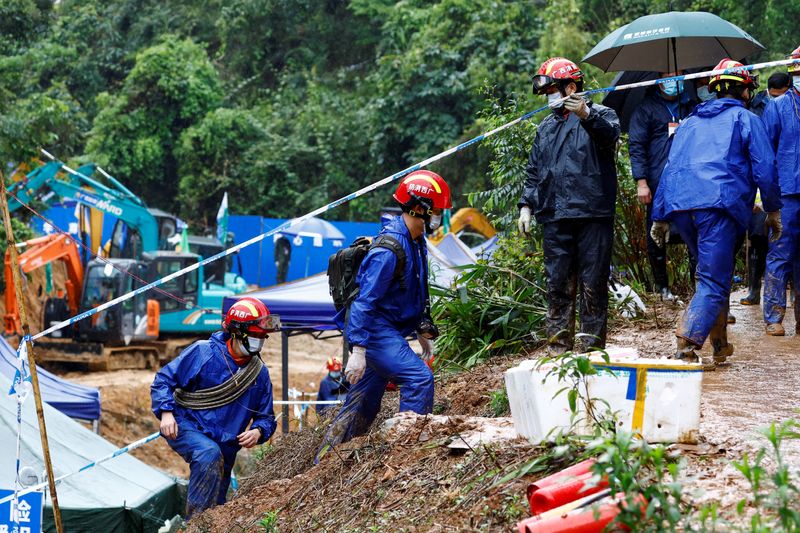By Jamie Freed and Allison Lampert
-China has launched an investigation into the crash of a China Eastern Airlines jet that plunged rapidly from cruising altitude into a mountainside with 132 people on board.
The crash of the Boeing 737-800 is China’s first deadly aviation accident since 2010 in a country that has had one of the world’s strongest safety records over that period.
There are international standards governing some parts of air crash investigations, but the practical management of them differs by country.
China will lead the investigation because the crash occurred on its territory, and the United States has the right to participate because the plane was designed and manufactured there.
CHINA’S CHAIN OF COMMAND
China’s State Council, the cabinet led by Premier Li Keqiang, has set up an investigation team led by the Civil Aviation Administration of China (CAAC) and the Ministry of Emergency Management. The search and rescue response also involves multiple other ministries.
The aviation safety office of CAAC, which has an accident investigation department, is leading the technical work.
The State Council oversees major industrial accidents and natural disasters, giving it a more direct political oversight element than crash investigations in places like the United States.
Zheng Lei, chair of the aviation department at Australia’s Swinburne University of Technology, said the high-level involvement signified the government was taking the situation seriously and would also help improve cooperation throughout China’s extensive bureaucracy.
CAAC only operates at the vice minister level, he said, so the State Council would allow for minister-level involvement.
HOW DOES CAAC COMPARE WITH FOREIGN COUNTERPARTS?
CAAC performs a dual role as the aviation regulator and crash investigator, whereas the United States splits those roles between the Federal Aviation Administration (FAA) and the National Transportation Safety Board (NSTB).
U.S.-based aviation analyst Robert Mann said he was unconcerned by CAAC’s dual role given it is common elsewhere. The United Arab Emirates and the Philippines, for example, do not split the roles.
Christopher Hart, a former NTSB head, said he believes it is important to have separate agencies because the factors behind accidents often include errors and omissions by the regulator that may be less likely to be included in a final report written by that regulator.
However, a State Council report into China’s last deadly crash, involving a Henan Airlines Embraer regional jet in 2010, did point out deficiencies in CAAC oversight.
WHEN WILL CHINA RELEASE MORE INFORMATION PUBLICLY?
Under international standards, a preliminary report into an accident needs to be lodged with U.N. aviation agency ICAO within 30 days.
Such initial reports tend to be factual and brief, laying out the information known to date from maintenance records, air traffic control recordings and the black boxes if found, rather than a cause of the crash.
There is no requirement to make the preliminary report public, though Indonesia, Ethiopia, Pakistan and Iran have done so in more recent crashes. India did not publicly release a preliminary report into a deadly 2020 crash of an Air India Express plane.
Anthony Brickhouse, an air safety expert at Embry-Riddle Aeronautical University, said he hoped CAAC produced a public 30-day report given the global interest.
Mao Yanfeng, a CAAC official, on Friday told reporters that the investigation team will follow international and Chinese rules in submitting the 30-day report to ICAO, but he did not say whether it would be made public.
A final report is due within a year, according to ICAO guidelines, though sometimes they can take longer.
China is the world’s biggest operator of 737-800s with more than 1,200 in service, so it could release any broader safety information involving the model more quickly, analysts said.
WHAT STEPS DOES CHINA TAKE AFTER AIR CRASHES?
In most countries, an accident report makes safety recommendations to the airline, regulator and manufacturer as appropriate but does not assign blame or call for punishment.
Prosecutions can occur after a crash.
The State Council’s final report into the 2010 Henan Airlines crash recommended demotions and demerits for many airline and regulatory officials and prosecution of the captain, who survived the crash that killed 44 of the 96 people on board.
Professor Zheng of Swinburne University said a punitive approach was common in China, where there was a desire to see the people responsible punished when accidents occurred.
“I think that’s the convention, just to remind people about their accountability for the area they are looking after,” he said.
Depending on the investigation results, China Eastern also risks consequences including fines, aircraft groundings and unfavourable treatment when applying for new routes and airport slots, Morningstar analyst Cheng Weng said.
(Reporting by Jamie Freed in Sydney and Allison Lampert in Montreal; additional reporting by Stella Qiu in Beijing, Martin Quin Pollard in Wuzhou and David Shepardson in Washington; Editing by Simon Cameron-Moore and Hugh Lawson)
